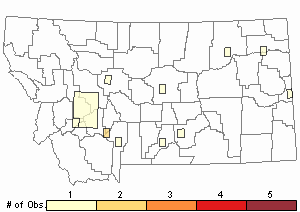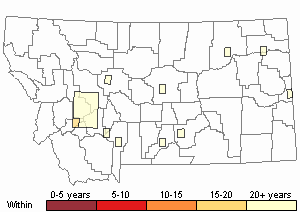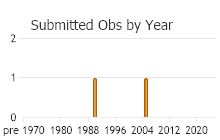View in other NatureServe Network Field Guides
NatureServe
Montana
Utah
Wyoming
Idaho
Wisconsin
British Columbia
South Carolina
Yukon
California
New York
Gladston's Spur-throat Grasshopper - Melanoplus gladstoni
General Description
The following comes from Brooks (1958), Vickery and Kevan (1985), Capinera et al. (2004), Capinera and Sechrist (1982), Pfadt (2002), and Scott (2010). A medium sized dark to yellowish-brown grasshopper with a mottled appearance. The wings reach or extend slightly beyond the abdomen tip. The abdomen is marked with dark and yellow bands. The hind tibia is normally red, tinged with purple, but sometimes greenish.
Phenology
The following is taken from Capinera et al. (2004), Capinera and Sechrist (1982), Pfadt (2002), and Scott (2010). The Gladston's Spur-throat Grasshopper is a late season hatching species compared to other rangeland species. Nymphs occur from mid-June to August, when most other rangeland species are adults, some at the end of their life cycle. Adults are present from August to October, even into November, until freezing temperatures end the adult stage.
Diagnostic Characteristics
Taken from Brooks (1958), Vickery and Kevan (1985), Capinera et al. (2004), Capinera and Sechrist (1982), Pfadt (2002), and Scott (2010). The body length to end of forewings is 17 to 21 mm for males, and for females 19 to 24 mm. Wings (tegmina) are spotted. A dark spotted, ivory line runs down the middle of the wings. Outer face of hind femur is yellow below and has 2 oblique dark bands on the upper half. The femur is also flattened at its base. The cercus of the male genitalia is bent inward at its apical quarter—this feature is diagnostic and unique to this species of Melanoplus.
Any number of Melanoplus species can be confusing without collecting male specimens for genitalia comparisons to make positive identifications.
Species Range
Montana Range
Range Descriptions

 Native
Native
Range Comments
The Gladston's Spur-throat Grasshopper ranges widely across the rangelands of western North America. A common species in the grasslands east of the Rocky Mountains, occurring from western Minnesota and Iowa, west to the front ranges of the Rocky Mountain states, and southward deep into Mexico. In Montana, this species has been recorded for 34 counties. (Brooks 1958, Vickery and Kevan 1985, Capinera et al. 2004, Capinera and Sechrist 1982, Pfadt 2002, and Scott 2010).
Observations in Montana Natural Heritage Program Database
Number of Observations: 14
(Click on the following maps and charts to see full sized version)
Map Help and Descriptions
Relative Density

Recency


 (Observations spanning multiple months or years are excluded from time charts)
(Observations spanning multiple months or years are excluded from time charts)
Habitat
This species inhabits dry uplands among short grasses and weeds on sandy and gravelly soils and is also present in foothills and mountain meadows up to 8500 feet elevation (Capinera et al. 2004, Capinera and Sechrist 1982, Pfadt 2002).
Food Habits
It is a polyphagous species. It seems to prefer forbs, but feed on a diversity of forbs, grasses, sedges, and other foods, such as seeds, fungi, and mosses. Some favored host plants include
scarlet globemallow (
Sphaeralcea coccinea),
Missouri goldenrod (
Solidago missouriensis),
fringed sage (
Artemisia frigida), and
Astragalus sp. Favored grasses include
blue gramma (
Bouteloua gracilis),
Kentucky bluegrass (
Poa pratensis),
little bluestem (
Schizachyrium scoparium),
needle-and-thread (
Stipa comata),
sand dropseed (
Sporobolus cryptandrus) (Capinera et al. 2004, Capinera and Sechrist 1982, and Pfadt 2002).
Reproductive Characteristics
Females begin laying eggs about 21 days after becoming adults. Egg pods are commonly laid in bare clay soil and contain 16 to 29 eggs arranged in two columns. Nymphs pass through 5 instars. The nymphal period averages about 56 days (Capinera and Sechrist 1982, Pfadt 2002).
Management
In the fall, Gladston's Spur-throat Grasshoppers will associate with other late-maturing species and invade fields of winter wheat in the green seedling stage. Such aggregations can cause significant damage to the edge rows of the crop (Pfadt 2002).
Stewardship Responsibility
References
- Literature Cited AboveLegend:
 View Online Publication
View Online Publication Brooks, A.R. 1958. Acridoidea of Southern Alberta, Saskatchewan, and Manitoba (Orthoptera). The Canadian Entomologist (Supplement 9) 90:5-92.
Brooks, A.R. 1958. Acridoidea of Southern Alberta, Saskatchewan, and Manitoba (Orthoptera). The Canadian Entomologist (Supplement 9) 90:5-92. Capinera, J.L. and T.S. Sechrist. 1982. Grasshoppers of Colorado: Identification, Biology, and Management. Fort Collins, CO: Colorado State University Experiment Station, Bulletin 584S. 161 p.
Capinera, J.L. and T.S. Sechrist. 1982. Grasshoppers of Colorado: Identification, Biology, and Management. Fort Collins, CO: Colorado State University Experiment Station, Bulletin 584S. 161 p. Capinera, J.L., R.D. Scott, and T.J. Walker. 2004. Field Guide to Grasshoppers, Katydids, and Crickets of the United States. Ithaca, NY. Cornell University Press.
Capinera, J.L., R.D. Scott, and T.J. Walker. 2004. Field Guide to Grasshoppers, Katydids, and Crickets of the United States. Ithaca, NY. Cornell University Press. Pfadt, R.E. 2002. Field Guide to Common Western Grasshoppers, 3rd edition. Laramie, WY: Wyoming Agricultural Experiment Station, Bulletin 912, modified by S. Schell and S. Schell for electronic publication. Accessed 19 February 2020. http://www.uwyo.edu/entomology/grasshoppers/field-guide/index.html#fieldguidetoc
Pfadt, R.E. 2002. Field Guide to Common Western Grasshoppers, 3rd edition. Laramie, WY: Wyoming Agricultural Experiment Station, Bulletin 912, modified by S. Schell and S. Schell for electronic publication. Accessed 19 February 2020. http://www.uwyo.edu/entomology/grasshoppers/field-guide/index.html#fieldguidetoc Scott, R.D. 2010. Montana Grasshoppers, Katydids, and Crickets A Pictorial Field Guide to the Orthoptera. MagpieMTGraphics, Billings, MT.
Scott, R.D. 2010. Montana Grasshoppers, Katydids, and Crickets A Pictorial Field Guide to the Orthoptera. MagpieMTGraphics, Billings, MT. Vickery, V. R. and D. K. M. Kevan. 1985. The grasshopper, crickets, and related insects of Canada and adjacent regions. Biosystematics Research Institute, Ottawa, Ontario. Publication Number 1777. 918 pp.
Vickery, V. R. and D. K. M. Kevan. 1985. The grasshopper, crickets, and related insects of Canada and adjacent regions. Biosystematics Research Institute, Ottawa, Ontario. Publication Number 1777. 918 pp.
- Additional ReferencesLegend:
 View Online Publication
View Online Publication
Do you know of a citation we're missing? Anderson, N.L. 1951. Field studies on the biology of range grasshoppers of southeastern Montana. M.Sc. Thesis. Bozeman, Montana: Montana State University. 96 p.
Anderson, N.L. 1951. Field studies on the biology of range grasshoppers of southeastern Montana. M.Sc. Thesis. Bozeman, Montana: Montana State University. 96 p. Anderson, N.L. 1962. Grasshopper-vegetation relationships on Montana grasslands. Ph.D Dissertation. Bozeman, Montana: Montana State University. 73 p.
Anderson, N.L. 1962. Grasshopper-vegetation relationships on Montana grasslands. Ph.D Dissertation. Bozeman, Montana: Montana State University. 73 p. Gillespie, R.L.1992. Dynamics of grasshoppers (Orthoptera: Acrididae) at a rangeland-crop interference. Ph.D. Bozeman, MT: Montana State University. 111 p.
Gillespie, R.L.1992. Dynamics of grasshoppers (Orthoptera: Acrididae) at a rangeland-crop interference. Ph.D. Bozeman, MT: Montana State University. 111 p. Hebard, M. 1928. The Orthoptera of Montana. Proceedings of the Academy of Natural Sciences of Philadelphia, Vol. 80:211-306.
Hebard, M. 1928. The Orthoptera of Montana. Proceedings of the Academy of Natural Sciences of Philadelphia, Vol. 80:211-306. Kirk, K. and C.R. Bomar. 2005. Guide to the grasshoppers of Wisconsin. Madison, WI: Wisconsin Department of Natural Resources, Bureau of Integrated Science Services PUB-SS-1008. 154 p.
Kirk, K. and C.R. Bomar. 2005. Guide to the grasshoppers of Wisconsin. Madison, WI: Wisconsin Department of Natural Resources, Bureau of Integrated Science Services PUB-SS-1008. 154 p. Larson, D.P. 1996. Evaluation of sweep sampling as a method for determining grasshopper community composition on rangeland. M.Sc. Thesis. Bozeman, MT: Montana State University. 92 p.
Larson, D.P. 1996. Evaluation of sweep sampling as a method for determining grasshopper community composition on rangeland. M.Sc. Thesis. Bozeman, MT: Montana State University. 92 p. Skinner, K.F. 1995. Plant and grasshopper community composition: indicators & interactions across three spatial scales. M.Sc. Thesis. Bozeman, MT: Montana State University. 144 p.
Skinner, K.F. 1995. Plant and grasshopper community composition: indicators & interactions across three spatial scales. M.Sc. Thesis. Bozeman, MT: Montana State University. 144 p.
- Web Search Engines for Articles on "Gladston's Spur-throat Grasshopper"
- Additional Sources of Information Related to "Insects"





